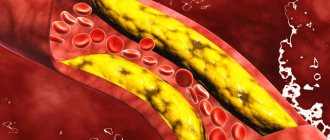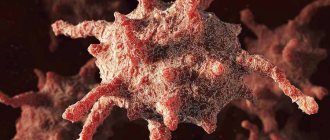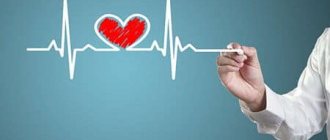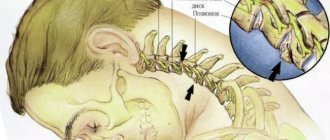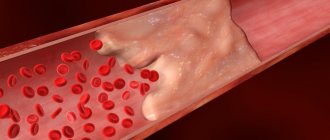For nine years now, World Thrombosis Day has been celebrated annually on October 13th. This disease not only causes severe discomfort, but can also be fatal if the symptoms are not treated correctly or the symptoms are ignored. In addition, the risk of thrombosis increases in those who have recovered from coronavirus. And given that the incidence of Covid in St. Petersburg is growing, many are at risk.
When thrombosis occurs, blood clots called thrombi form inside the blood vessels. If such a bundle clogs an artery, hypoxia occurs, complete deprivation of oxygen and cell death.
What to do if you suspect you have thrombosis?
Phlebologist Sergei Drobyazgo, in a conversation with NEVSKY NEWS, advised not to confuse thrombosis with banal complaints from the legs. He noted that savvy St. Petersburg residents now do not self-medicate, but go to the doctor with their questions, as they should do. Only in a hospital can this disease be confirmed with certainty.
“In principle, our people are now informed. Everyone knows very well that coronavirus increases the risk of thrombosis, therefore, in principle, a person now does little self-medication, turns to specialists, and receives assistance in the required amount,” Drobyazgo noted.
pixabay.com/PD/
Forewarned is forearmed. This is the only method of self-medication that doctors trust. The phlebologist noted that it would do well for every person to remember some risk factors that are associated with the formation of blood clots. He advises taking preventive measures, especially if there are prerequisites for the formation of blood clots.
“If you have a long trip, a flight, if you are overweight, have diabetes, have chronic heart disease, have swollen legs, or are in a hospital, then once again you need to remember that the best way to prevent is prevention,” the doctor emphasized.
The phlebologist advised to use compression stockings and move regularly. He recommends breaking up long monotonous work in one place with short walks. This way the blood in the vessels will not stagnate.
“If you spend an hour or more without moving, do a little exercise. You need to get up and walk around. Try to get enough sleep; if your chronic disease is worsening or you are in a hospital, avoid heat stress. If you belong to the risk category and have recently been ill, you don’t need to go somewhere on vacation right away, give your body time to recover,” the phlebologist advised.
Nevskie News / Andrey Lyashchev
In addition, he recommended listening to the opinions of doctors. They will prescribe all the necessary medications, and therefore you do not need to take anything on your own to prevent thrombosis.
“Now everyone takes anticoagulants in a row. If you need it, upon discharge from the hospital, or your local physician will advise you on the necessary remedy,” the doctor said.
Ways to prevent thrombosis after operations and injuries
If you require surgery or have suffered a serious injury, your doctor will need to take a detailed look at your medical history and decide on how to protect against thrombosis. The risk of deep vein thrombosis is associated with limited mobility after surgery and injury. Usually it increases immediately after the intervention and during the first 10 days after it, but can persist for up to several months, especially with forced physical inactivity.
Practical studies show that the risk of thrombosis is significantly reduced when using regional (conduction) anesthesia. Therefore, modern specialists prefer it if it is possible to bypass the use of general anesthesia.
The list of postoperative and post-traumatic preventive measures also includes:
· Taking anticoagulants (strictly as prescribed);
· Wearing elastic compression and bandage underwear;
· Elevated position of the legs during rehabilitation;
· Early physical activity (at the first opportunity);
· Painkillers to facilitate movement;
· Physical therapy under the supervision of an instructor.
Compression hosiery and other auxiliary products should be selected by a specialist, taking into account individual measurements.
Trust your doctors!
You should not trust doctors in matters of treatment. According to Drobyazgo, medicine has made a huge step forward over the past year. Drugs such as tableted anticoagulants have appeared - these are the drugs that disappeared from the shelves, but have now reappeared.
“Previously, we only had injections, or there were drugs that were quite dangerous. Now there are drugs that have proven themselves very well, there are very few side effects and risks of bleeding, but they still exist, so you need to take them only for the appropriate indications,” the doctor noted.
In addition, doctors are now less and less forced to subject patients to any surgical procedures. In many cases, patients with thrombosis are not even hospitalized, but are left to be treated on an outpatient basis according to the recommendations of doctors.
Press service of NIIZMM DZM /
Doctors told how to prevent blood clots in blood vessels
The risk of developing thromboembolism in women is very high. “All cancer diseases increase the risk of blood clots and thromboembolism. Pregnancy leads to the risk of thrombosis, because the fetus is a physical obstacle to the outflow of venous blood,” Pryadko said.
In addition, the use of hormonal contraceptives also carries a high risk of blood clots. “Unfortunately, our gynecologists who prescribe hormonal contraceptives do not even inform their patients about this, although this is written in the annotation, but people also rarely read the annotations for the drugs,” the doctor added.
Men have a greater risk of thrombosis during long flights. “For example, a famous Russian tennis player developed thrombosis after a long flight. The same thing happened with half the roster of one famous football team, which often made long flights,” Pryadko noted. If a person travels for a long time on a train or on an airplane, he needs to change his position and move his legs.
Prevention of varicose veins is with compression stockings or knee socks. “They are indicated for a person who makes a long trip by road, rail, or plane. If the car ride is more than three hours, anyone should wear compression stockings,” he said. In Switzerland, for example, two pairs of compression stockings are provided free of charge by the healthcare system.
Special vegetables and fruits
According to the head of the clinical diagnostic department of the Central Clinical Hospital No. 2 named after Semashko of Russian Railways, vascular surgeon and chief cardiologist of Russian Railways Alexey Zudin, the risk of blood clots is reduced by foods that are rich in vitamin K - broccoli, spinach. “People who are at risk of thrombosis should remember this. There was a study that lingonberries and citrus fruits are also good at reducing the risk of blood clots,” said the cardiologist.
According to him, some physical activities increase the risk of developing varicose veins, for example, weightlifting. Sports such as running, swimming and cycling, on the contrary, are good for blood vessels.
Anatoly Pokrovsky, President of the Russian Society of Angiologists and Vascular Surgeons, Head of the Department of Vascular Surgery at the Vishnevsky Institute of Surgery, said that in the 50s of the last century, a study was conducted on the development of cardiovascular diseases in the British and Finns. “The composition of the food seems to be the same. But in England, a leaf of green salad is always added to the dish, but in Finland this is not the case. And they concluded that vegetables, which should be included at every meal, are of great importance,” the doctor said.
He believes that the emphasis should be placed not on what people eat, but on a person’s weight.
Taking care of the heart means taking care of the blood vessels
Thrombosis is a complication of a number of diseases, noted phlebologist Elena Smirnova . In this regard, she recommended, as a preventive measure for this disease, to take care of yourself in order to prevent diseases of the cardiovascular system.
“Such measures include a correct lifestyle, which includes normalizing weight, combating overweight and obesity, physical activity, and preventing a sedentary lifestyle. At a minimum, some kind of exercise, gymnastics, sports. Proper nutrition is complete, balanced, with various vitamins and microelements. And, of course, a preventive examination by a doctor in order to prevent the disease from reaching later stages, although diagnose them in the early stages. Use modern minimally invasive treatment methods. Every patient can receive them absolutely free of charge, under the compulsory medical insurance system,” the phlebologist listed.
freepik.com / Designed by Freepik
Let's define the terms
But to answer the main question of this article, we suggest understanding the terminology.
After all, there are two diseases: thrombophlebitis and thrombosis. Prevention of both is important, but it is achieved in different ways. The main differences between the two diseases are presented in the table below.
So, the table presents the main characteristics of both diseases, their similarities and differences. The main difference between thrombophlebitis and thrombosis is the localization (superficial or deep veins), as well as the mechanism of disease development. However, both of them pose a real threat to life, so it is very important to prevent blood clots.
| Thrombophlebitis | Thrombosis | ||
| The essence of the problem | Formation of thrombi (blood clots) | ||
| Localization | Superficial veins | Deep veins | |
| Features of the affected vessels | Usually develops in altered veins (for example, with varicose veins), including those with damaged walls | Can develop in healthy vessels, resulting from a violation of blood properties | |
| Phlebitis | Present | May occur without inflammation of the vein, which explains the mild severity of symptoms | |
| Factors contributing to the development of the disease | Varicose veins, other vascular pathologies, vein injuries, pathological changes in the composition of the blood, imbalance in the functioning of the coagulation and anticoagulation systems of the blood, a decrease in the speed of blood flow in the venous bed (or in some part of it), infections, etc. | ||
| Symptoms | Redness and thickening in the area of the vein, sharp pain, especially when walking and exertion, noticeable swelling | Swelling of the leg, pain that occurs in response to stress | |
| General poor health | Maybe | Maybe | |
Uncontrolled use of hormonal contraceptives
Due to the high content of estrogen, some contraceptives activate the blood coagulation system, which results in the formation of blood clots.
How to warn. Avoid long-term uncontrolled use of hormonal contraceptives, which are contraindicated in case of varicose veins, thrombophlebitis, acute liver diseases, diabetes mellitus, and malignant diseases. Therefore, before prescribing them, it is necessary to undergo an examination: look at the condition of the liver, mammary glands, hemostasis, and do an ultrasound of the female genital organs. And repeat these studies annually.
By the way
In addition to the reasons listed above, the following are also at risk of developing venous thromboembolism: patients with atrial fibrillation, heart failure; pregnant women; obese people; patients with diabetes mellitus; heavy smokers.
Varicose veins
According to official statistics, every fourth Russian suffers from chronic venous insufficiency of the leg veins. However, the real incidence of venous vessels significantly exceeds the official indicators, because those suffering from this disease, as a rule, turn to a doctor already at those stages when swollen varicose veins not only clearly spoil the beauty of the legs, but also significantly worsen the quality of life.
Article on the topic
In spite of varicose veins. How to help your blood vessels
How to warn. The best way is not to start the disease by contacting a phlebologist at the first symptoms. They are famous. Among the subjective ones (those that the patient feels) are pain, heaviness, and fatigue of the legs. There may also be cramps, itching and burning. Objective (visual) – varicose veins, intradermal reticular varicose veins (spider veins), swelling of the legs.
Symptoms associated with spinal pathology (this is exactly what Dmitry Maryanov ), flat feet, and joint disease are often mistaken for venous disease. Only a phlebologist can correctly assess the patient’s complaints, who will prescribe ultrasound Dopplerography of the vessels of the legs, and, if necessary, prescribe anticoagulants (blood thinners) and elastic compression products (stockings, knee socks, tights). Modern surgical techniques make it possible to avoid removing veins and making skin incisions.
Our information
At different times, the following died from pulmonary embolism: Wilhelm II (Emperor of Germany), Frida Kahlo, Francoise Sagan, Lyudmila Gurchenko, Leonid Gaidai. Other recent victims of a detached blood clot are football player Alexey Arifullin and Zenit sports director Konstantin Sarsania.
